|
| |||
 |
Into F1: Learning to Work | ||
| by Will Gray, England | |||
|
In a new series of articles, Will Gray analyses the different jobs available on the technical side of Formula One, finds what skills are required, and suggests ways for budding engineers to get their foot in the door
Any advert for a job in Formula One specifies a requirement for experience as well as high degree qualification. This doesn't mean a recent graduate is counted out! A degree is indeed an essential part of the education required for industry, but it is near worthless without some good engineering experience. This training can be gained from many areas, and it doesn't have to be a motor racing company you learn from - many principles in Grand Prix engineering, particularly knowledge of computer aided design, are universal.
Whilst at university, the long holidays offer plenty of time to go out and get some experience, but it need not begin then. Generally, you can begin gaining work experience from the age of around fifteen, and the more you can get on your CV, the better. Don't expect to jump straight into a Formula One team - it's much harder than that! However, smaller firms may be able to help - but don't expect to get paid for your time, just remember that doing it now will pay in the long run.
Club racing, such as Formula Ford, Formula Renault, or even Formula Three, all offer a unique opportunity to be right where the action is, but without the pressure of Formula One. It is worth trying to spend time with one of these kind of teams to get used to life in pit lane, or back in the work shop. Although there is less opportunity on the design side, many teams are often grateful for an extra pair of hands, and a graduate engineer who has seen some experience in a lower formula will be a more tasty prospect for any F1 team.
British universities wanted a piece of the action, and so began Formula Student, the European competition run to the same rules as Formula SAE. Going into its third year of existence in 1999, the competition boasted seven running cars and a total of 21 entrants. It is rapidly growing, and most importantly for budding student motor sports enthusiasts, Formula One teams have taken a great interest.
Backed by the Society of Automobile Engineers and the Institution of Mechanical Engineers, the European competition also has heavy industry support (from Jaguar, Ford, Shell, and MIRA), along with backing from two other institutions - the Motorsport Industry Association (MIA) and the Motor Sports Association (MSA). Designs in both competitions are aimed at club competitors taking part in 'Autocross' events - an American one-at-a-time speed event around cones in a large tarmac area. They comprise on an open wheel, open cockpit car, powered by a 4-stroke engine which must be less that 610cc, but can be supercharged.
The principles in race car design are similar whatever the formula, so lessons learned here are of tremendous use to all the areas of Formula One you may want to get into. Designs are advanced. A number of teams in the US competition use monocoque chassis designs, and many teams using professional analysis packages to test the structural integrity and the dynamics of their car. As is critical in all racing categories, areas such as weight and centre of gravity must constantly be considered, with all components required to be as light as possible, whilst innovation is also encouraged in the marking scheme.
Any experience is good, and anything you do over and above your course will put you one up on the rest. The opportunities degree courses offer, along with the Formula Student competition will certainly achieve that to some extent, but it is also important to obtain good work experience. You have to go out there and get it, and may have to work for free, but in the long run, you'll be glad you did.
|
| Will Gray | © 2000 Kaizar.Com, Incorporated. |
| Send comments to: gray@atlasf1.com | Terms & Conditions |
 Experience in manufacturing is also essential, and the more time you can spend hands-on in the early part of your career, the better engineer you will be. Often a good clue to whether you should become and engineer is a keenness to tinker with mechanical things. I am sure every engineer, at some point in his or her past, has pulled something apart to see how it goes back together, and a good way of gaining knowledge of cars is to tinker with them, or even to build your own kit car. However, spending time at any engineering company is also sure to offer some time in the manufacturing environment.
Experience in manufacturing is also essential, and the more time you can spend hands-on in the early part of your career, the better engineer you will be. Often a good clue to whether you should become and engineer is a keenness to tinker with mechanical things. I am sure every engineer, at some point in his or her past, has pulled something apart to see how it goes back together, and a good way of gaining knowledge of cars is to tinker with them, or even to build your own kit car. However, spending time at any engineering company is also sure to offer some time in the manufacturing environment.
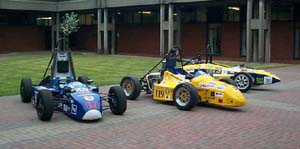 Component part companies can be good to get into, as there is less demand for places at such companies, and you will at least have gained experience working on part of an F1 car. It is also worth looking at other formulae to gain some early motor racing experience. The world of motor racing for many may end with Formula One, but it certainly doesn't begin there.
Component part companies can be good to get into, as there is less demand for places at such companies, and you will at least have gained experience working on part of an F1 car. It is also worth looking at other formulae to gain some early motor racing experience. The world of motor racing for many may end with Formula One, but it certainly doesn't begin there.
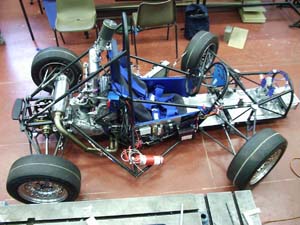 Companies are rapidly agreeing that there is no better way to gain hands on experience than the Formula Student/SAE competitions. Entered by university teams throughout the world, the competitions offer teams of students the chance to build and test their own racecar designs against each other. The idea of the competition began in the United States in 1979, under the banner of Formula SAE, and encouraged by the interest of General Motors, Ford and Chrysler, it is now entered by over 100 teams, and has engineering firms scouring the pits to grab the up and coming engineers of the future.
Companies are rapidly agreeing that there is no better way to gain hands on experience than the Formula Student/SAE competitions. Entered by university teams throughout the world, the competitions offer teams of students the chance to build and test their own racecar designs against each other. The idea of the competition began in the United States in 1979, under the banner of Formula SAE, and encouraged by the interest of General Motors, Ford and Chrysler, it is now entered by over 100 teams, and has engineering firms scouring the pits to grab the up and coming engineers of the future.
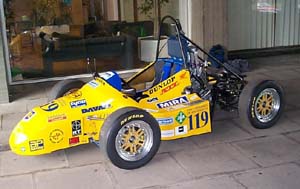 The first to take the plunge was Jordan Grand Prix, who are officially supporting both Southampton and Imperial Universities in the 2000 competition, with additional backing for Cambridge coming in 2001. All are gunning for that Formula Student crown, and Jordan see the competition as an excellent way to study a group of potential engineers and select graduates for possible job placements.
The first to take the plunge was Jordan Grand Prix, who are officially supporting both Southampton and Imperial Universities in the 2000 competition, with additional backing for Cambridge coming in 2001. All are gunning for that Formula Student crown, and Jordan see the competition as an excellent way to study a group of potential engineers and select graduates for possible job placements.
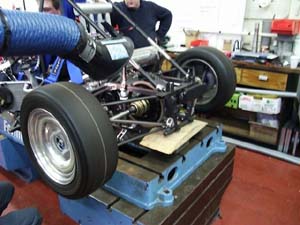 There are other rule restrictions, particularly in the area of safety, but the scope allows for innovation, and the organisers define a huge range of key elements involved in the competition - project planning, management, teamwork, problem solving, fund raising, budgeting, and component sourcing, to name but a few! All these are essential qualities required for any engineer, as are skills in design and construction, an area where the competition comes into its own.
There are other rule restrictions, particularly in the area of safety, but the scope allows for innovation, and the organisers define a huge range of key elements involved in the competition - project planning, management, teamwork, problem solving, fund raising, budgeting, and component sourcing, to name but a few! All these are essential qualities required for any engineer, as are skills in design and construction, an area where the competition comes into its own.
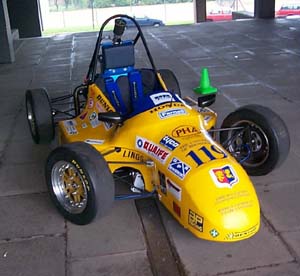 In the British event, a year of car design and building culminates in the now annual event at the National Exhibition Centre in Birmingham during July, with the winners of this event invited to compete in the larger American competition at the University of Texas in August. Designs are judged by presentations and an inspection, as well as four performance tests for the running cars - a skid pan, an acceleration test, an autocross, and an endurance test. So how do you get into it? Well, it is a university event, and an ever increasing number of universities around the world are taking up the challenge. It is a matter of seeking out the universities that offer the option, as well as a good course...and the getting the grades to get into them!
In the British event, a year of car design and building culminates in the now annual event at the National Exhibition Centre in Birmingham during July, with the winners of this event invited to compete in the larger American competition at the University of Texas in August. Designs are judged by presentations and an inspection, as well as four performance tests for the running cars - a skid pan, an acceleration test, an autocross, and an endurance test. So how do you get into it? Well, it is a university event, and an ever increasing number of universities around the world are taking up the challenge. It is a matter of seeking out the universities that offer the option, as well as a good course...and the getting the grades to get into them!